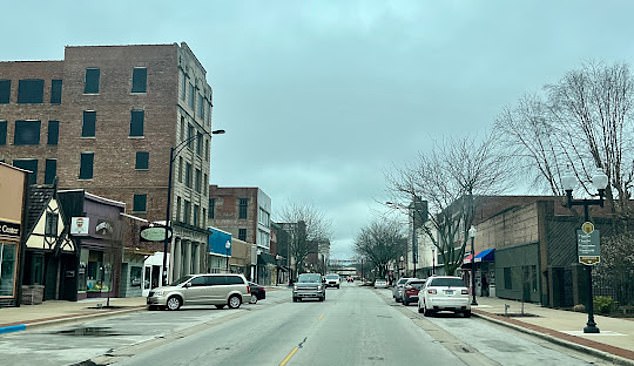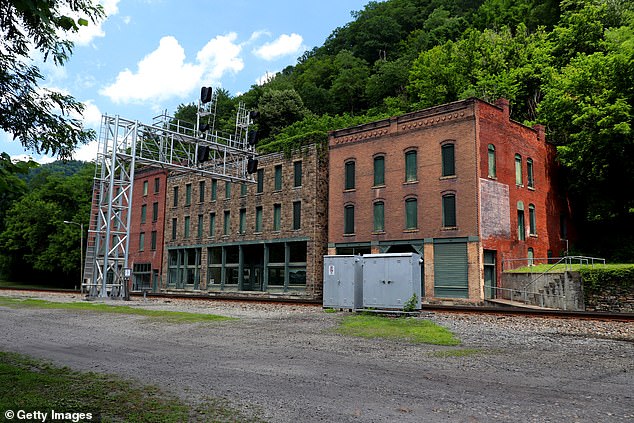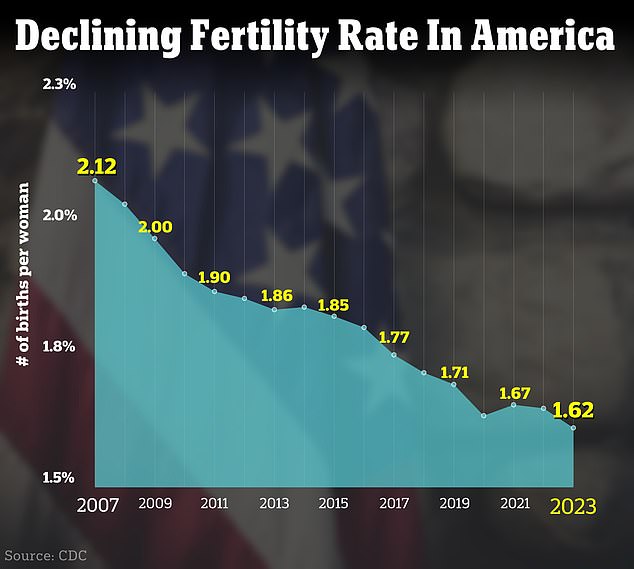As many as 15,000 cities across America could depopulate and vanish in the coming decades, becoming ghost cities by 2100, researchers have warned.
Scientists told DailyMail.com that historic, 43-year-low birthrates and major youth migrations have worked in a vicious cycle to turn economically declining areas across the nation into empty shells of their former selves.
More than 80 percent of cities in Vermont and West Virginia are now well on their way to vanishing, researchers at the University of Illinois Chicago found this year.
And by their estimates, New Hampshire, Michigan, Mississippi and Illinois are not far behind: All four states are likely to suffer steep population drops in at least three quarters of their cities, echoing more well-known declines across rural America.


‘The net result is a demographic perfect storm,’ as University of New Hampshire sociologist Kenneth Johnson told DailyMail.com: ‘outmigration, fewer young adults to have children, and lower fertility among those fewer young women who remain.’
In the US as a whole, the total fertility rate — or the number of children born to the average woman over her lifetime — fell to 1.62 births per woman in 2023, the lowest rate since the government began tracking this data in the 1930s.
For populations to stay the same size, a region or a country must achieve a ‘replacement level’ fertility rate of at least 2.1 births per woman, according to experts.
But data on birth rates and death rates in isolation can mislead on the core economic issues because ‘youth exodus’ is at the heart of this problem, according to Johnson, who serves as a senior demographer at UNH’s Carsey School of Public Policy.
‘Net migration losses, particular of young adults, that have been sustained for several decades, are more influential in fostering depopulation,’ he told DailyMail.com.


‘In some rural counties that are now depopulating, a county might lose as much as half of its high school graduating class to outmigration,’ Johnson explained.
‘If such age specific outmigration is sustained for several generations — as it has been in many depopulating areas — the next generation of high school graduates will be only half as large,’ he continued, ‘because so few from the previous generation remained to have children.’
‘This process then repeats itself,’ he said.
US Census data taken in 2010 and 2020 tells the story of these shrinking urban areas’ paths to ‘ghost city’ status, revealing which are disappearing fastest.

In Vermont, the city of Rutland has lost 5.24 percent of its residents since 2010 and even the state’s most populous city, Burlington, has experienced declines losing 0.5 percent of its population since 2020, according to US Census Bureau estimates.
In West Virginia, the city of Beckley saw a 5.9 percent decrease in population from 2010 to 2023, nearly the kind of drop that can lose a place its federal status as a city.
Cumberland, West Virginia and surrounding Allegany County, in fact, lost 9.3 percent of it population from 2010 to 2020, a downgrade disqualifying them as a city worthy of federal transportation planning assistance, per the Cumberland Times-News.
‘As population decreases, local revenue decreases, making it hard to maintain infrastructure,’ as environmental engineer Sybil Derrible explained to DailyMail.com.
‘This massive decline,’ Derrible, senior author of the University of Illinois Chicago (UIC) study, and his team warned, ‘will bring unprecedented challenges, possibly leading to disruptions in basic services like transit, clean water, electricity and internet access.’
While states other than Vermont and West Virginia had less cities declining, in total, some of their cities do appear to be shrinking faster individually.
Danville, Illinois has witnessed a staggering population drop of 14.6 percent from 2010 to 2023, for example, and the state’s largest city, Decatur, shrank 9.78 percent.

Ionia, Michigan lost 8.4 percent of its residents from 2020 to 2023, a drop that also led to the closure of its Michigan Reformatory prison.
Between 2010 and 2020, Berlin, New Hampshire shrank 5.9 percent and Pine Bluff, Arkansas, dropped by 12.5 percent.
In a third of that time, from 2020 to 2023, the city of Sandy in Utah has also shed 5.5 percent of its residents.
But the plight of Jackson, Mississippi — which has lost over a quarter of its population since its height of 200,000 residents in 1980 — remains the starkest ‘canary in the coal mine’ for the bleak future of these urban centers.


Serious disruptions due to underfunded public utilities and services, are already happening, in fact, in some of the very cities and states that Derrible’s team highlighted in their study, published in the journal .
Evaporating tax revenue in Mississippi’s state capital Jackson, ‘the fastest shrinking city in America,’ has led to over 750 ‘boil water notices’ since 2016, for example.
Jackson city officials now routinely beg locals to protect themselves from its crumbling sewage and water treatment system issuing such BWNs for weeks on end.
It’s underfunded and decaying water treatment and pipe network reached such a crisis in 2022 that the nearly 600 Mississippi National Guardsmen were deployed to distribute bottled water and non-potable water to struggling residents.
Infrastructure failures will not only plague these ‘ghost cities,’ however, as Virginia Iglesias, interim director of the University of Colorado, Boulder’s Earth Lab noted.
In a bizarre twist, the latest research suggests that many of the ‘lucky’ areas experiencing population growth — like Phoenix, Arizona and the Florida coast — are at ground zero for the myriad extreme weather crises looming on the horizon.
As more young adults, pressured to go to where the jobs are, move to zones at high-risk of freak storms, Iglesias warns they will increase ‘the probability of disaster.’

‘Our most recent analysis shows that the fastest-growing states over the 15 years from 2008 to 2023 were predominantly in the South and West,’ public policy expert Joanna Biernacka-Lievestro of The Pew Charitable Trusts explained to DailyMail.com.
‘For more than a half-century, people have gravitated toward Sun Belt states,’ she explained, ‘drawn by employment opportunities, as well as lower costs of living and warmer climates compared with other regions.’
But the results of those choices have been stark in places like Tampa, Florida and Myrtle Beach, South Carolina — two of the fastest growing metropolitan areas in the US.
Florida’s population has actually tripled since the 1970s statewide, ballooning to over 22 million as US citizens and immigrants both have chased tourism jobs, sunny skies and low prices.
That influx has skyrocketed the annual expected losses from hurricane damage by 180-190 percent in the Sunshine State.
The explanation is perhaps best understood by US Census data showing that the state regularly comes up in third place for total number of mobile homes in trailer parks: an indicator of too much demand in Florida’s burdened housing market.
‘Put simply, the benefits that Florida has reaped from strengthening its building codes over the last half century have been overwhelmed by population growth,’ Matt Junge, an underwriter for insurance firm Swiss Re, reported in 2023.
‘Everyone from insurers to corporations to the public sector must adapt,’ he said.


Property insurers have advocated that they and their fellow institutions act now, in part, because the millions of ordinary Americans who are simply seeking a better life for themselves are unlikely to change these troubling patterns alone.
‘There are 20 different factors in weighing where people want to move,’ according to data scientist Mahalia Clark, a graduate fellow at the University of Vermont where she tracks migration patterns across the US.
‘Higher up on the list is ‘where friends and family live,’ ‘where I can afford to move,” as Clark explained.
‘Much lower down,’ she said, ‘is ‘what is the risk of hurricane or wildfire.”
Rising temperatures, all by themselves, have been a local scourge in the rapidly growing city of Phoenix, which recorded 100 consecutive days above 100 degrees Fahrenheit in 2024.
Often thought of as a risk mainly for elderly shut-ins, heat stroke deaths killed a four-month old baby and a 3-year-old girl in the Arizona city this summer.



But unlike these booming metropolitan areas, with their growing tax bases, the rest of America’s increasingly hollowed out cities will face a harder challenge of how to fund badly needed protective measures and repairs — requiring entirely new ideas for how to maintain critical infrastructure.
‘Planning now is all based on growth,’ said environmental engineer Sybil Derrible.
‘We need to shift away from growth-based planning,’ Derrible said, ‘which is going to require an enormous cultural shift in the planning and engineering of cities.’
But as Ken Johnson at UNH emphasized, declining birthrates across the US will worsen the demographic shifts seen by these youth migrations, badly impacting local economies and elder care beyond crumbling local government services.
‘Although early expectations were that many of these births were only delayed, lower marriage rates and a rise in the proportion of childless women suggests that a significant number of these births will be foregone entirely,’ he wrote in a new study.
‘This has implications for health care, schools, child-related businesses, and eventually for the labor force,’ Johnson said.
‘If low fertility persists,’ a recent Pew study agreed, ‘states will need to look more for other ways to grow their tax bases or they could face challenges over the long term.’

While many explanations have been offered to explain these declining birthrates, decades of federal government data suggests that little has changed across generations when it comes to most young American’ ‘desire to start a family.
One 2023 study, conducted by Ohio State and the University of North Carolina at Chapel Hill, found young Americans still aspire to have two children on average.
The study pooled generations-worth of responses obtained by the US Department of Health and Human Services (HHS) for their National Survey of Family Growth.
‘Slightly more young people plan to have no children now than 30 years ago,’ the study’s authors, sociologists Karen Benjamin Guzzo and Sarah Hayford, wrote for The Conversation.
‘But still, the vast majority of US young adults plan to have kids: about 88 percent of teenage girls and 89 percent of teenage boys.’
Tufts University urban planning scholar Justin Hollander, who reviewed the new ‘ghost cities’ research for Scientific American this year, noted that the pressure is on federal and local leaders to anticipate and adjust to these emerging crises.
‘These are not isolated problems to the Detroits of the world,’ he said
‘Depopulation is everywhere, and the paper is right to demand that cities face this fact and begin to honestly prepare for this possible future,’ Hollander contends.
For his part, Derrible said he hopes that his work with his University of Illinois Chicago colleagues is not seen as a cause for despair, but a call to action.
‘The only thing I can say is that the fact many cities are losing population is inevitable and common to many countries,’ Derrible told DailyMail.com.
‘It’s an opportunity to be more creative,’ Derrible said. ‘We should see this not as a problem but as an opportunity to rethink the way we do things,’

